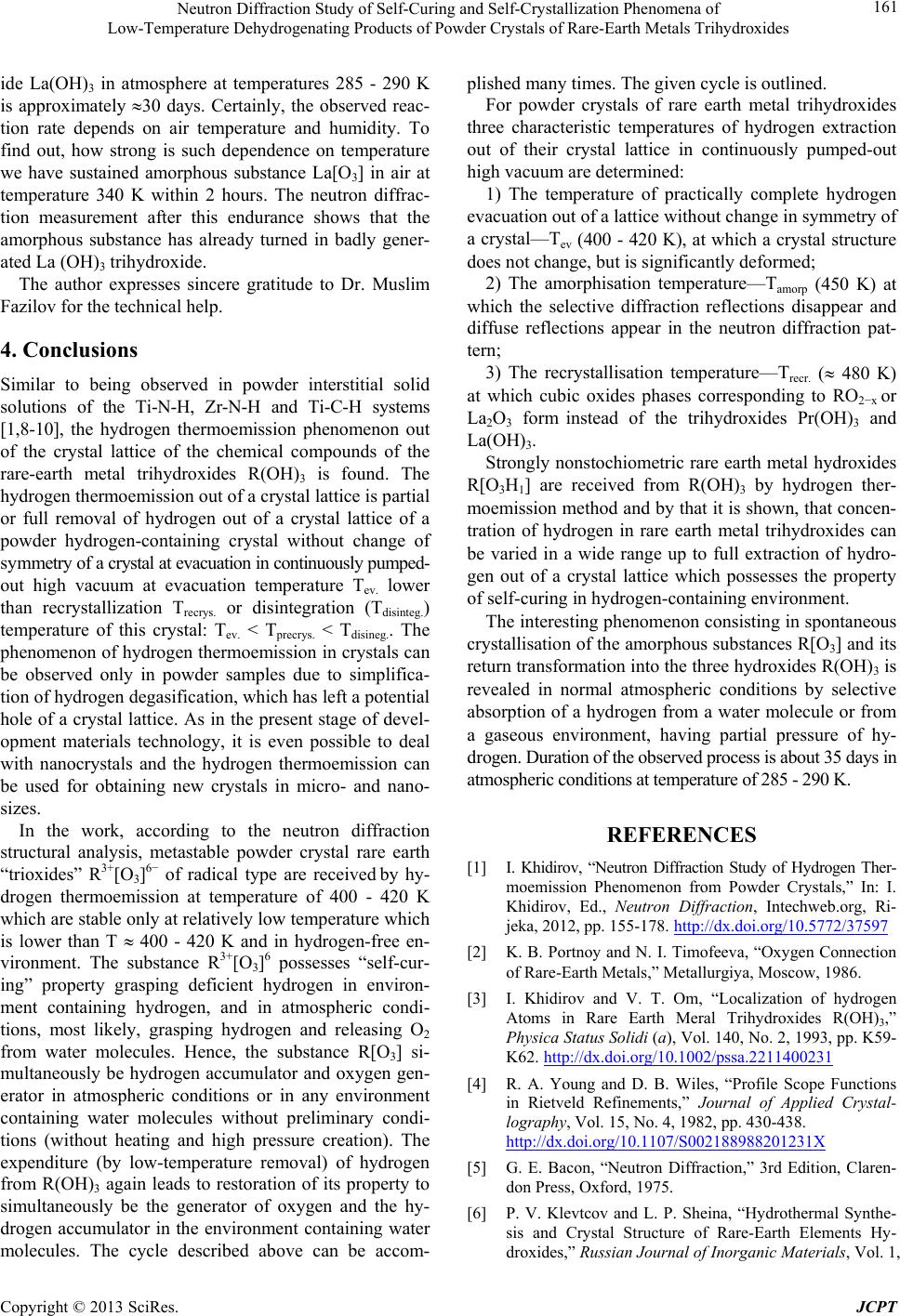
Neutron Diffraction Study of Self-Curing and Self-Crystallization Phenomena of
Low-Temperature Dehydrogenating Products of Powder Crystals of Rare-Earth Metals Trihydroxides
Copyright © 2013 SciRes. JCPT
161
ide La(OH)3 in atmosphere at temperatures 285 - 290 K
is approximately 30 days. Certainly, the observed reac-
tion rate depends on air temperature and humidity. To
find out, how strong is such dependence on temperature
we have sustained amorphous substance La[O3] in air at
temperature 340 K within 2 hours. The neutron diffrac-
tion measurement after this endurance shows that the
amorphous substance has already turned in badly gener-
ated La (OH)3 trihydroxide.
The author expresses sincere gratitude to Dr. Muslim
Fazilov for the technical help.
4. Conclusions
Similar to being observed in powder interstitial solid
solutions of the Ti-N-H, Zr-N-H and Ti-C-H systems
[1,8-10], the hydrogen thermoemission phenomenon out
of the crystal lattice of the chemical compounds of the
rare-earth metal trihydroxides R(OH)3 is found. The
hydrogen thermoemission out of a crystal lattice is partial
or full removal of hydrogen out of a crystal lattice of a
powder hydrogen-containing crystal without change of
symmetry of a crystal at evacuation in continuously pumped-
out high vacuum at evacuation temperature Тev. lower
than recrystallization Тrecrys. or disintegration (Tdisinteg.)
temperature of this crystal: Тev. < Трrecrys. < Tdisineg.. The
phenomenon of hydrogen thermoemission in crystals can
be observed only in powder samples due to simplifica-
tion of hydrogen degasification, which has left a potential
hole of a crystal lattice. As in the present stage of devel-
opment materials technology, it is even possible to deal
with nanocrystals and the hydrogen thermoemission can
be used for obtaining new crystals in micro- and nano-
sizes.
In the work, according to the neutron diffraction
structural analysis, metastable powder crystal rare earth
“trioxides” R3+[O3]6− of radical type are received by hy-
drogen thermoemission at temperature of 400 - 420 K
which are stable only at relatively low temperature which
is lower than Т 400 - 420 K and in hydrogen-free en-
vironment. The substance R3+[O3]6 possesses “self-cur-
ing” property grasping deficient hydrogen in environ-
ment containing hydrogen, and in atmospheric condi-
tions, most likely, grasping hydrogen and releasing О2
from water molecules. Hence, the substance R[O3] si-
multaneously be hydrogen accumulator and oxygen gen-
erator in atmospheric conditions or in any environment
containing water molecules without preliminary condi-
tions (without heating and high pressure creation). The
expenditure (by low-temperature removal) of hydrogen
from R(OH)3 again leads to restoration of its property to
simultaneously be the generator of oxygen and the hy-
drogen accumulator in the environment containing water
molecules. The cycle described above can be accom-
plished many times. The given cycle is outlined.
For powder crystals of rare earth metal trihydroxides
three characteristic temperatures of hydrogen extraction
out of their crystal lattice in continuously pumped-out
high vacuum are determined:
1) The temperature of practically complete hydrogen
evacuation out of a lattice without change in symmetry of
a crystal—Tev (400 - 420 K), at which a crystal structure
does not change, but is significantly deformed;
2) The amorphisation temperature—Тamorp (450 K) at
which the selective diffraction reflections disappear and
diffuse reflections appear in the neutron diffraction pat-
tern;
3) The recrystallisation temperature—Тrecr. ( 480 K)
at which cubic oxides phases corresponding to RO2−x or
La2O3 form instead of the trihydroxides Pr(OH)3 and
La(OH)3.
Strongly nonstochiometric rare earth metal hydroxides
R[O3H1] are received from R(OH)3 by hydrogen ther-
moemission method and by that it is shown, that concen-
tration of hydrogen in rare earth metal trihydroxides can
be varied in a wide range up to full extraction of hydro-
gen out of a crystal lattice which possesses the property
of self-curing in hydrogen-containing environment.
The interesting phenomenon consisting in spontaneous
crystallisation of the amorphous substances R[O3] and its
return transformation into the three hydroxides R(OH)3 is
revealed in normal atmospheric conditions by selective
absorption of a hydrogen from a water molecule or from
a gaseous environment, having partial pressure of hy-
drogen. Duration of the observed process is about 35 days in
atmospheric conditions at temperature of 285 - 290 K.
REFERENCES
[1] I. Khidirov, “Neutron Diffraction Study of Hydrogen Ther-
moemission Phenomenon from Powder Crystals,” In: I.
Khidirov, Ed., Neutron Diffraction, Intechweb.org, Ri-
jeka, 2012, pp. 155-178. http://dx.doi.org/10.5772/37597
[2] K. B. Portnoy and N. I. Timofeeva, “Oxygen Connection
of Rare-Earth Metals,” Metallurgiya, Moscow, 1986.
[3] I. Khidirov and V. T. Om, “Localization of hydrogen
Atoms in Rare Earth Meral Trihydroxides R(OH)3,”
Physica Status Solidi (a), Vol. 140, No. 2, 1993, pp. K59-
K62. http://dx.doi.org/10.1002/pssa.2211400231
[4] R. A. Young and D. B. Wiles, “Profile Scope Functions
in Rietveld Refinements,” Journal of Applied Crystal-
lography, Vol. 15, No. 4, 1982, pp. 430-438.
http://dx.doi.org/10.1107/S002188988201231X
[5] G. E. Bacon, “Neutron Diffraction,” 3rd Edition, Claren-
don Press, Oxford, 1975.
[6] P. V. Klevtcov and L. P. Sheina, “Hydrothermal Synthe-
sis and Crystal Structure of Rare-Earth Elements Hy-
droxides,” Russian Journal of Inorganic Materials, Vol. 1,